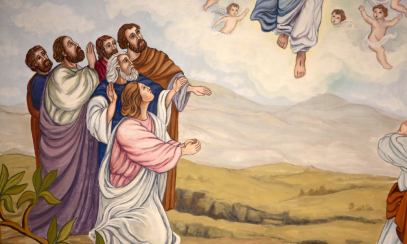What Will We Be Saying at Mass? The Communion Rite
On the night before he died, Jesus ate supper with his Apostles. He broke bread, blessed wine, and invited them to eat and drink. But this was much more than a meal – he offered them his very body and blood. Moreover, he commanded them to continue to do this in memory of him. For more than 2,000 years, we have never failed to follow this command.
Every time we gather for Mass, we are still nourished by both word and sacrament. After listening and responding to the Scriptures,we offer our great prayer of thanksgiving (eucharistia in Greek) acknowledging all that God has done for us and recalling, especially, Christ’s institution of the Eucharist. Then we prepare to receive the paschal banquet when, as a community of believers, we are formed into an even more perfect union with God and with each other. That is why we call this sacrament “holy Communion.” Let’s take a closer look at the rites that surround this sacred meal.
The Lord’s Prayer
The rite begins with the prayer that Christ himself taught us. (Mt 6:9-13) The Lord’s Prayer has been part of the Mass since the sixth century, when it was officially added by Pope Gregory the Great. In the new Roman Missal, it will be the only text that retains old English language such as “art” and “thy.” Too many people have memorized it this way. The priest will offer a slightly different introduction and a slightly altered embolism (an “insert”) that will more directly reflect Scripture. The final phrase, For the kingdom, the power, and the glory…, has its roots in Byzantine Christian practice.
Priest: At the Savior’s command and formed by divine teaching, we dare to say:
All: Our Father, who art in heaven…
Priest: Deliver us Lord, we pray, from every evil, graciously grant peace in our days, that by the help of your mercy we may be always free from sin and safe from all distress as we await the blessed hope and the coming of our savior, Jesus Christ (Ti 2:13)
All: For the kingdom the power and the glory are yours now and forever.
Sign of peace
St. Paul had urged his communities to “greet one another with a holy kiss.” (Rom 16:16) The location of the sign of peace has changed over the centuries. Early on, it was part of the Liturgy of the Word – after the intercessions, just before we carried gifts to the altar of sacrifice. (Mt 5:23-24) In the 6th century, it was placed immediately after the Lord’s Prayer to link it more closely with holy Communion. An invitation to the sign of peace can be found in the Missal of Pius V (1570) as a private prayer of the priest. The sign of peace was restored after Vatican II. In the new translation, only the last line of the presider’s invitation will change.
Priest: Lord Jesus Christ, who said to your Apostles, Peace I leave you, my peace I give you, (Jn 14:27) look not on our sins but on the faith of your Church, and graciously grant her peace and unity in accordance with your will.
Priest: The peace of the Lord be always with you.
All: And with your spirit.
Priest: Let us offer each other the sign of peace.
The fraction of the bread or Lamb of God
In the early Church, the entire eucharistic celebration was called “the breaking of the bread.” Now, this simple rite “… signifies that the faithful are made one body (1 Cor 10:17) receiving Communion from the one Bread of Life which is Christ, who died and rose for the salvation of the world.” (GIRM 83) The priest breaks the bread into smaller pieces or distributes the hosts from one vessel into several to prepare for the distribution of holy Communion. He will also take a small particle of host and drop it into the Precious Blood.
This is accompanied by the ancient litany, Lamb of God… If necessary, multiple tropes can be added since this is music to cover a ritual action. (GIRM 83) The final one will always end with “grant us peace.” This is the only chant which may be used during the fraction.
Priest: May this mingling of the Body and Blood of our Lord Jesus Christ bring eternal life to all who receive it. (quietly)
All: Lamb of God, you take away the sins of the world, have mercy on us. Lamb of God, you take away the sins of the world, have mercy on us. Lamb of God, you take away the sins of the world, grant us peace.
Invitation
Next, the priest will invite us to Communion. He elevates the host slightly and says:
Priest: Behold the Lamb of God, behold him who takes away the sins of the world, Blessed are those called to the Supper of the Lamb.
These words echo what John the Baptist said when he saw Jesus. (Jn 1:29) They conclude with the vision of John in Revelation, when the angel told him to write down “blessed are all those called to the banquet of the Lamb.” (Rv 19:9) We respond:
All: Lord, I am not worthy that you should enter under my roof, only say the word and my soul shall be healed.
These new words will more closely resemble the words of the centurion who asked Jesus to cure his servant, even though he did not deem himself worthy to have Jesus enter his house. (Mt 8:8 and Lk 7:6-7)
We too, acknowledge with humility that we are unworthy to have Jesus enter our very being.
Holy Communion
Appropriately, our Communion procession is all about unity as we receive the sacrament of unity. While we individually receive the Lord, we also all receive the Lord – it is a “Jesus and us” moment. Even our music underscores this unity. It begins when the priest consumes the body and blood of Christ and does not conclude until all have received. Following an ancient tradition, the minister says to each communicant, “The body of Christ” or “The blood of Christ.” In a profound exchange of faith, we respond, “Amen.” This Aramaic word means “to pitch one’s tent stake,” that is, to state with strong conviction, “So be it” or “I believe.”
Prayer after Communion
After a period of silence or after a hymn, during which we all thank God for his great gift of the Eucharist, the server brings the missal to the presider and he prays the Prayer after Communion. He prays that this sacrament may affect our lives and bear great fruit in God’s Kingdom. The words we will use in the Communion Rite are both ancient and new. May they remind us, again and still, of Jesus’ invitation to encounter him in the breaking of the bread.



